Gianna Maria Gatti:
(translated from the Italian by Alan N. Shapiro)

An interest in botany forms the basis of the training of Christa Sommerer: she dedicated herself to this after her secondary studies, enrolling in the Faculty of Biology and Botany of Vienna. Her intention was to investigate nature by applying and elaborating methods suitable to the classification of plants for the purpose of achieving the formulation of systematic rules. The scientific approach combined the morphological observation of the vegetable world with the analysis of the internal biological processes determining the dynamics of growth and of development. Contemporary to the acquisition of these specific knowledges, however, there matured in Sommerer the need to create something personal deriving from the inspiration and stimuli that a thorough examination of the subject of nature had awakened in her: in turning towards artistic studies, the journey to be undertaken, the one which really responded to her needs, took shape. Artistic production gave her the chance to express herself: as well as drawing on her previous experiences, she constructed a bridge between art, biology and botany, but only in the early 1990s, attending the Stäedelschule, Institute for New Media, in Frankfurt under the direction of Peter Weibel, did she discover the opportunities offered by the new technological and informatic media, and, adopting them, oriented her research in this direction. The encounter that she had there with the Frenchman Laurent Mignonneau, also a graduate of the Stäedelschule in Fine Arts, later in video and computer art, was fundamental; his skills in computer programming left a definite mark on the association that established itself between the two colleagues in those years.
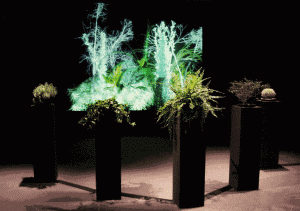
The Sommerer-Mignonneau couple, from 1992 until today, has realized a series of emblematic works counted among the principal exponents of that artistic tradition centered on genetics and on Artificial Life; their strong point is to have weaved together their respective knowledges in such a way as to introduce a different approach to art, to nature, and to life.
The two artists have developed in their installations the concept of “Art as Living System,” defined by themselves as “a complex interrelation and interaction of real and virtual entities that engage in a dialogue, which causes and effects the appearance of a different space of matter and mind. Relativity Theory proved that the cosmic web is alive by showing that its activity is the very essence of being. On an abstract level one could say that the activity of these interactive systems could be considered to be alive as they are processes of continuous change, adaptation and evolution.” Keeping the paradigms of biology as primary reference and converting their key elements into informatic language through genetic algorithms resolutely conceived from time to time by Mignonneau, they have created original artificial micro-worlds populated by living beings whose formation and development are obtained from the combination of evolutionary instructions inside the program and from interaction with the public. The result is a work of art that is no longer static or predetermined but, on the contrary, just like life, evolves in real time in reaction to the unpredictability of the actions of users, and of the relationships among the same artificial organisms. The role of Sommerer and Mignonneau, beyond the indispensable originating phase, is concentrated on the setting up of the system, which means defining and planning the organization and the basic processes of the particular habitat: a communicative and interactive space that, once thriving, lives autonomously from its creators, self-managing the relationships with the outside and those continuous exchanges which determine the production and reproduction of the creatures living in them. In the same way, each user contributes personally to produce these creatures, but as soon as they are born they free themselves from him, ready to interact with other participants, to modify and progress. There no longer exists a single figure in charge of the work: it is neither in the hands of the artist nor of the public; from their complicity defined and prefixed objects are not created, but life is created, animated by evolutionary processes.
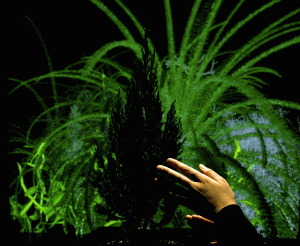
If in A-Volve, of 1994, the living creature generates itself through a drawing, sketched by the user on a video screen and materializing within a small water-filled glass pool containing real water, in the following work Life Spacies, of 1997-99, is a text written and sent via e-mail to form the organism that simultaneously appears inside a vegetal environment visible on a screen. The variety of artificial beings is guaranteed by the fantasy of the users and their personal aesthetic taste: it is they who invent their appearance on which depends the ability to adapt to the environment; the sketches and the texts, in fact, contain all the information and properties necessary to define the single individual, composing in other words its ‘genetic inheritance’. Specific programs analyze each graphic variant, both in the sketch and in the writing, and translate it into a quality that the creature takes on. In A-Volve, if the appearances of the organism are already established by the user’s sketch, it is from the drawn form, from the lines of the profile, from the speed of execution, that its typology of behavior and movement is determined; specific algorithms control what is defined as a ‘wave function’: they enable the creature to move with a naturalness similar to that of a jellyfish, modifying and recalculating in real time its form in relation to the actions performed. It is instead the Text-to-Form editor software (or Text-to-Form coding system) that converts the text written and sent by the user to the appropriate website of Life Spacies, in the visual, acoustic and motor identity of the artificial organism: from the letters which construct the word and the sentence, from their order and from their repetition, from the sequences of the words, from the syntactic construction, are obtained the various parameters corresponding to the form, color, texture, dimension, body development, number and distribution of limbs, emitted sounds, movement. The complexity of the being that is simultaneously generated is directly proportional to the complexity of the drawing or of the written text; it follows in addition that the greater completeness and richness of characters makes the individual more suitable to survive.
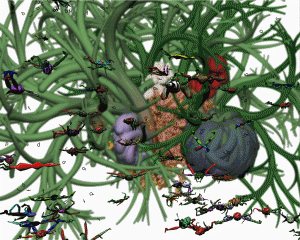
Inside the aquarium of A-Volve as in the vegetal space of Life Spacies, there develops a true ecosystem where the process of life is governed by the laws of natural selection and by the propagation of the genotype, as well as by the influence of the environment: the more vigorous and larger being has survival over the weaker, it ‘eats its energy’, it strengthens itself to the point of becoming a dominant individual capable of mating with one similar to it, and, in this way, giving birth to a third creature who acquires the genetic character of both parents; these look after it until it has taken on a certain consistency and independence to then die of old age. Such a cyclic nature of relationships guarantees the lineage of the species but also takes into account, following what in nature come to be defined as random genetic mutations, the formation of new species, new bio-configurations. To the factors of chance which already regulate the living being, disruptions are added which come from the real external environment, provoked by the actions of the users who can interact with the creatures: touching them, encouraging their approaching each other, and hence the mating between two of them, defending the weakest from the attack of a predator, even, after having ‘seized’ one of them, inducing it to clone itself. From the exchange that is established between human and artificial being emerges also the character of the creature; for example, it can take on a reserved, timid behavior and escape, removing itself from the encounter with the hand of man, or else react with more confidence and play with it.
The objective of Sommerer and Mignonneau is to make the user notice, through interaction, how situations and behaviors are always unexpected and different, and, more generally, to discover and experience the characteristics of the new forms of Artificial Life that, although they respect the evolutionary dynamics that occur in nature, are no longer based on carbon compounds but on the silicon chips of the computer. The technosciences make it possible to calculate and codify the processes of the living being, but also to reformulate them by combining them with the possibilities deriving from informatics and communications, creating intelligent systems that act according to a different spatio-temporal organization, favoring the contamination between real and virtual, between nature and artifice.
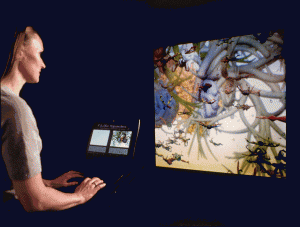
In Life Spacies unknown users of the Internet network can generate at a distance the creatures that in real time come to life on the two screens installed in two separate rooms of the ICC (NTT Inter Communication Center) Museum of Tokyo; it is in them that the visitors present in each room are video-projected: their image appears inside the same three-dimensional virtual space, allowing them to find that they are together in the same environment, exploring interaction with the creatures which inhabit it. This artificial world becomes the only meeting point, the place where the intentions and actions of the participants express themselves at the same time, all equally indispensable co-authors of the complex evolution of the organisms of the system.
A-Volve like Life-Spacies can be considered to be among the most representative installations of Sommerer and Mignonneau in the sphere of Artificial Life in so far as they show with powerful efficiency the results of their research directed to the application of the processes of evolutionary biology for the purpose of creating three-dimensional images of living forms: in both cases – it is a question of beings who simulate animal behavior to a certain extent similar to human behavior – not only do they facilitate the user in his comprehension of the dynamics that regulate the system, but they also clarify the implicit message of a possible alternative to the existence composed of organic material.
Each micro-world developed over the years by the author-couple also places particular emphasis on one of the elements essential to life: in A-Volve it is water, in the later Phototropy, of 1994-95, it is light – thanks to whose nourishment cocoons immersed in darkness are transformed first into small larvae and then into flying insects – whereas in Life Spacies it is vegetation, an intricate environment that offers refuge to creatures.
And it is precisely with vegetation that the two artists open their production, in an artistic journey that seems to have symbolically traced the stages of the unfolding of life itself on earth; before in fact proposing ‘animal’ organisms, they dedicate their debut work, Interactive Plant Growing, created in 1992-93, exclusively to botanic biology, interpreted artistically, where real plants act as an interface for the formation of virtual vegetation.
The impulse towards such an orientation certainly has its origin in the studies carried out by Christa Sommerer, as well as in her interest in computing and new technologies, which has allowed her in particular to approach the research of Lindenmayer into the creation of virtual plants by means of algorithmic formulas capable of giving to the vegetable a unique aesthetic beauty. But for the method of the Dutch biologist and mathematician, Sommerer and Mignonneau substitute their own, thanks to which the modelization of the growth of the plants follows a different structural criterion, based, as Sommerer explains, simplifying the principal characteristic that distinguishes their formulation, no longer on the ramification in segments typical of the L-System of Lindenmayer, but on the development of a ring that can expand in three dimensions of space aligned with the x, y and z axes. Several points distributed on the circumference of this ring compose the various parameters, each one programmed distinctly and in a different way, that control the drawing functions inherent to form, dimension, rotation, and color of the vegetal element; the action of the users influences the variability of the parameters, assuring the constant formation of typologies of plants that are always diversified and unpredictable.Influencing morphological randomness is also the introduction of a certain degree of chance in the parameters of the system, increasing in this way the similarity with what happens in nature during the evolutionary process.
The uniqueness of the software of Interactive Plant Growing created by Sommerer and Mignonneau does not lie only in the innovative elaboration of the ring, but also in the particular faithfulness to the truth of the images produced, which attest to a profound knowledge of natural vegetables: starting with the analysis of the correlations between forms and processes of their growth, the two artists have developed the algorithms of the program and digitalized the growth of more than twenty-five plants belonging to several botanical species such as fern, moss, vine, trees, and cactus.
The research carried out by Sommerer and Mignonneau refers to the studies of the Scottish biologist and zoologist D’Arcy Wentworth Thompson, centered on the fundamental role of mathematics and geometry in describing the correlations and links among the principles that regulate growth, structure and form of the various categories of the living being and of nature. His treatise, On Growth and Form, published in 1917, reveals to what degree he was a precursor in the field of structural biology: availing himself of comparative observation, conducted through drawings translated into mathematical models, he achieves results confirmed many years later by informatic means. From his deductions are drawn the words cited at the beginning of the presentation text of Interactive Plant Growing: “The rate of growth deserves to be studied as a necessary preliminary to the theoretical study of form, and organic form itself is found, mathematically speaking, to be a function of time… We might call the form of an organism an event in space-time, and not merely a configuration in space.”
The plants that the two artists have selected and digitalized have been chosen for their distinguishable compositional characteristics, observable from the visualization on the screen during the interaction of the visitors with five real plants. These plants, placed in pots on suitable pedestals arranged in a semi-circle in front of a large screen and illuminated from above, are the first element encountered on entering the dark space of the installation; when invited to touch them, the users discover that to their gesture corresponds on the screen at first the appearance, then the growth, of plants having a certain resemblance to the real one touched, and that such interaction exercises a control over the appearance and evolution of artificial vegetables. The structural and chromatic conformation, the articulation of the branches and the distribution of the leaves, the placing in space, are all variables depending on the modality and intensity of the human-plant contact – weak or strong, brief or prolonged: each transformation occurs in real time and can involve several visitors at the same time. The landscape created and projected on the screen never reaches saturation but proceeds by infinite overlappings: in that these are computer-synthesized images in a virtual space, the plants do not have a physical presence. But even unlimited virtual growth is subject to hidden dangers: the garden of real plants organized by the two artists hides a killer plant which if touched completely wipes out the entire composition, clearing the screen. To interpret this menacing and devastating – or regenerating, depending on one’s point of view – role, they have ironically thought of a prickly cactus, in nature not likely to arouse the desire to touch it.
Ferns, small trees like small cypresses or bonsai, climbing plants like ivy, grasses like tiny bamboo or other kinds of herbaceous plants, mosses, cactus: for the first time in an artistic installation, natural organisms are used as an interface between user and informatic system. By virtue of their state as living beings, these natural organisms represent, in communion with man, the component indispensable to the functioning of the work.
Technically the interaction is based on the combination of the electric potential of the visitors and that of the real plants: each of them is equipped with its own voltage detected by a sensor placed among the roots in the soil of the flowerpot. When human voltage is added via the proximity or contact of the hand, the device perceives this difference and, sending it in number form to an appropriate protocol, converts it into the data that the growth program needs. Each minimal change of value is decoded in real time and constitutes the variables that influence the design operations which generate the virtual forest. The activation of this series of stages starts from what Sommerer defines as the sensitive capacity of the plants, by means of which they react to the impulses of man: “The vegetable beings are like antennae or transmitters: if you come into a room they perceive, through the electric potential, your presence.” He further clarifies Interactive Plant Growing: “Everything is based on the sensitivity of the plants, and we have studied, measured and decodified this sensitivity. For each plant we must make a different setup: for example, we know that the fern is very sensitive while the cactus is not. Therefore, in the case of the cactus, we have had to increase the values of the setup to obtain the desired reactions.”
The work of control just described, necessary to the attaining of a power level detectable by the informatic system, is repeated at each new exhibition of the work because the plants, although selected from several botanical families of reference, will always be different, and must be chosen directly on the spot, adjusting to the availability of local specimens. As for the technological devices, the use of such interfaces requires special maintenance if the duration of the exhibition covers a prolonged period of time. Often the responsibility, rather than being given to computer technicians, is handed over to gardeners who are given the task of replacing them if, as the days go by, they show signs of collapsing. They are living organisms which evolve and can be affected negatively by the context in which they are placed. “In our work,” the two artists declare, “we have been most interested in the invention of Natural Interfaces, as they transport the content of life, variation and personality. For example, using living plants as interface not only provides a new and unusual connection between computers and a living being, but also poses the question of what a plant is, how we perceive it, and how we interact with it. Natural Interfaces allow us to transcend our personality into virtual space. They also avoid the fear that one has when putting on unpleasant devices for entering virtual space.”
If, on the one hand, the user finds himself facilitated by a reassuring natural element, it is equally true that, in the sphere of new media art, it is more usual to interact wearing or manipulating sophisticated interfaces rather than establishing contact with a real plant. The originality of Interactive Plant Growing lies in having subverted these schema, giving the possibility to the user to enter into communion with another living being not only to experience the pleasure of rediscovering the other, but also to generate together a form of artificial vegetable life starting from the strong analogies with the real one. Thus a circular relationship of cause-effect and of complementarity between real and virtual is established; the most immediate relation is between the ways that the user acts on the real plant and the consequent development of the image of the synthetic vegetable visualized on the screen, which in its turn stimulates the successive moves. To this is added the connection of external forms between real and artificial plants, as well as, even if less evident to the user, of internal processes of growth, being the virtual evolution governed by algorithms which are designed in similarity to the mechanisms of natural evolution. According to Pier Luigi Capucci: “The artificial springs from the transformation of the natural, and the natural bases on the artificial the possibility of acting more effectively. The artificial is one evolutionary development of the natural, yet it also bears witness to – and retains a memory of – the vitality of such evolution.”
The user, involved in a circuit where what dominates is the vegetal identity, as the interactive game proceeds, gains awareness of this double vitality of the plants on which is constructed a reciprocal exchange: the vital fascination and curiousity that is displayed in the sudden development of the artificial beings, bearers of a new possible biology and of a wider conception for understanding the living being, accompanied by greater awareness of the latent vitality of the real plant. The vitality of the latter emerges in contrast to that which is produced on the screen, visible proof of the capacity of a plant to also contribute to a creative process, directly deriving from the living being and able to develop a particular and variable form of ‘communication’ with the outside, starting from the physical quantity that all living beings possess: energy. A dynamic force not so evident as in men or animals, but that Interactive Plant Growing nevertheless makes manifest to the user during the interaction, as well as rendering it measurable and translatable into numeric instructions thanks to electronic technology.
The contact that is established between man and plant is explained in depth in the invisible and impalpable passage of energy “in a relationship of grafting with the vegetal element,” according to the effective definition of Lorenzo Taiuti, who draws from agricultural practice this image to communicate the sense of how the contribution of the user is carried by the vegetable. From the unusual grafting between two such different realities is born a different vegetable life configuration that has in itself the complicity of botanical biology but also of man and technology, a conjunction interpreted by Piero Gilardi as “a sort of new cosmic communion,” since for the artist the poetic sense of the installation lies “in managing to establish an emotional and communicative continuity between the real dimension and the virtual dimension, and to humanize the virtual space by transforming it into the scenery of a communication of cosmic energy, more exactly, of a transduction of human energy into botanical energy, into natural energy.”
In their subsequent work, Trans Plant, of 1995, Sommerer and Mignonneau give the user the possibility of entering this virtual space and interacting with the artificial vegetable that grows there. Trans Plant was produced by the Metropolitan Museum of Photography of Tokyo, and is part of the permanent collection of the museum. The environment of the installation is a dark room and involves on a technical level a large screen placed in a semi-circular position delimiting the area passable by the visitor who is filmed by a camera positioned just above the screen and transferred into the latter through a mechanism of video projection. The two artists have patented a new system of “3D Video Key” that for the first time allows the participant to enter the three-dimensional virtual space without having to wear any devices, to appear himself in three-dimensional format, and to receive the impression of being physically part of the synthetic vegetal landscape by which he finds himself surrounded. This is an installation of non-immersive virtual reality. The prevailing vision is of himself inside the new world that induces him to act on the basis of what he encounters and develops in it; gradually the user realizes that it is his own movements which determine the composition of the environment, and he discovers spontaneously the flow of instructions which regulate it: if he walks, the grass starts to sprout following each step of his, forming a green carpet, if he remains still, plants germinate and grow into bushes, if he spreads his arms out, the plants increase in size, if he leans his upper body forward or backward, this acts on their color density, while the speed and frequency of his gestures define the botanical species that accumulate around him. The result of this unlimited freedom of action that is given to the user is the creation of always different and personalized spaces which, on the one hand, express his sensitivity and fantasy, but which, on the other hand, also reflect his physical consistency: the height, the build, of he who interacts influencing the forms and colors of the artificial vegetables, introducing thereby further variations and differences, for example, between the action of an individual adult and that of a child. Sommerer explains with these words the idea that underlies Trans Plant: “We wanted to enter the forest without having to touch anything, without having to interact with any media, on the contrary physically, with our body as the only interface!”
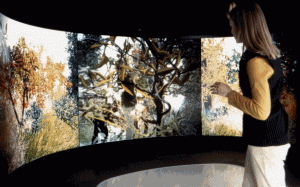
No longer only the will, but the entire body of the user becomes the central element of the installation, the only tool used to communicate that will; this means to reacquire above all confidence with the whole of one’s body, confidence and nonchalance in gestures, suppleness in movements and in one’s relations with space; it means learning to express oneself with the body and being aware of it. All the movements carried out by the person are filmed and sent in real time to the informatic system that transforms them into data used to trigger the various parameters that manage the process of growth of the vegetables.
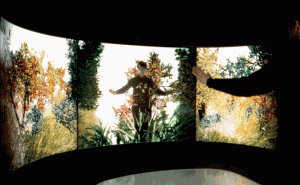
In Trans Plant, the software developed for Interactive Plant Growing was applied, adapting it to the requirements and to the typology of interaction of the work; in addition, if the principles of development and of evolution of the plants are identical, the botanical species chosen to populate the virtual environment are different. Sommerer and Mignonneau were as always inspired by the vegetation of the context in which the work was created, a factor that indicates the attention of the two artists to the observation of nature of the place, and their taste in characterizing their installations in situ; in this case, it is the Japanese autumn with its prevalence of bamboo and of trees of bright orange and bright red tonality typical of the season.
Trans Plant can be considered to be the ideal continuation of Interactive Plant Growing, a further step for the user in experiencing in the first person the artificial natural.
In Interactive, the first block to overcome, in terms of approach to the installation, consists in being able to touch the ‘work of art’, a gesture that is usually prohibited by tradition and culture, in so far as it is considered an object to look at with a sort of distance and reverence. The five living plants stand majestically on their columns dominating the scene like five sculptures to be admired: elevated as a work of art, real nature is placed at the center of attention to be touched and to activate the interactive process that brings the entire work to life. Thanks to the mediation of the real plants, the user discovers the beauty of Artificial Nature that opens up a new horizon on the screen that he has in front of himself. The distance that is created between the participant and these new vegetables, visible but not touchable, is filled by Trans Plant, where the user finds himself immersed in that virtual scenery, to live it from the inside, becoming an inhabitant capable of acting directly to modify it. Since these are impalpable images, the system of telepresence allows the user to feel part of the three-dimensional environment: he can move inside it, exploring the space, entering into contact with the plants by touching them or hiding behind their leaves, going around a trunk and above all, without needing any interface, using exclusively his own body to give life to nature, to put a personal stamp on what the two authors define as a virtual jungle: “The aim of Trans Plant is to create a personal environment where visitors finds themselves freely interacting with the virtual space, becoming part of it and essentially creating this space by themselves.” Sommerer and Mignonneau introduce man into a dimension where the living vegetable reacts, grows and develops in the present solely by virtue of its presence; they offer an escape from reality and from its temporal and spatial limits thanks to which man can question himself in a completely new relationship with nature; he has himself taken on the consistency of the artificial, becoming in his turn an image within an environment of images.
The two artists have achieved such results translating their experience of the living being through the languages of technologies, convinced that it is those languages which, from among everything that exists in the present world, are able to reestablish the dialogue with nature: “In general I believe that technology can lend a hand to understand and strengthen our knowledge of nature,” Sommerer explains. “In our work, the relationship with technology is close, very strong; technology and nature explore each other. Technology allows to construct a sort of other nature, an Artificial Nature that, I believe, renders better visible real nature.”